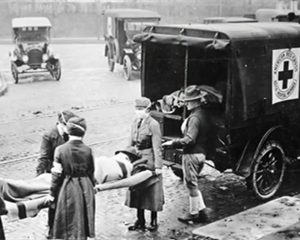(单词翻译:单击)
Another explanation is the one hinted at earlier: since the pandemic had originated there, Chinese citizens had already developed an immunity to it.
另一种解释来自前些时候的暗示(特此声明这是谣言):由于疫情起源于中国,所以中国公民已经对它产生了免疫力。
By the early months of 1919 the rage of the pandemic was relatively tamed, and I stress relatively.
到了1919年的头几个月,疫情相对缓和,我强调的是相对缓和。
The early Spring of the year saw a third wave making the rounds throughout the globe.
那年初春,第三波疫情浪潮席卷了全球。
Although it did not match the speed, reach and virulence of the Autumn wave, it was still deadly.
尽管它的速度、范围和毒性不比秋天那波,但它仍是致命的。
On March 5th 1919, a young Canadian man, Harold, wrote to a friend in Illinois:
1919年3月5日,一位名叫哈罗德的加拿大年轻人在给伊利诺斯州的朋友的信中说:
"There are an awful lot of people dying just now on account of the flu. A little girl next door was buried today and there is a lady up the street that is pretty sick and my little sister is just getting over it … So I guess it is pretty near my turn …"
“现在有很多人死于流感。隔壁的一个小女孩今天被埋了,街那头有个女人病得很重,我的小妹妹刚刚康复……所以我想也快轮到我了……”
We don't know if Harold made it or not.
我们不知道哈罗德是否活了下来。
The third sweep was followed by a Fourth Wave, less severe, which lingered on in locations such as Scandinavia, the South Atlantic and Sicily.
第三波流感大扫荡之后是第四波,第四次大扫荡盘旋在斯堪的纳维亚、南大西洋和西西里岛等地,不过没那么严重。
It is still debated whether this was a mutated strain of the original virus, or a new one altogether.
这究竟是原病毒的变异株还是一种全新病毒仍然存在争议。
One of the last documented victims of the Fourth Wave was a little girl from Palermo, Rosalia Lombardo.
第四波疫情的最后一个有记录的受害者是一个来自巴勒莫的小女孩,名叫罗莎莉娅,隆巴尔多。
She had been born on the 13th of December 1918, at the height of the Autumn flu in Europe, and passed away aged only two, on the 6th of December 1920.
她出生在1918年12月13日,也就是欧洲秋季流感最严重的时候,1920年12月6日她去世了,年仅两岁。
Her father, aggrieved by such a sudden and meaningless death, asked for her body to be preserved as if she were still asleep.
她的父亲对这样突然而毫无意义的死亡感到非常难过,要求把她的尸体保存起来,就像她还在睡觉一样。
One century later, Rosalia can still be seen sleeping in the Capuchin Catacombs of Palermo.
一个世纪后,人们仍能看到罗莎莉娅睡在巴勒莫的卷尾墓穴里。
This unwitting memorial to the Great Pandemic is now known as 'the most beautiful mummy in Europe'.
这具不知不觉中成为了纪念大流行的木乃伊现在被称为“欧洲最美丽的木乃伊”。
At a high level, flu viruses are divided into four types, from A to D.
在高水平上,流感病毒分为四种类型,从A到D。
And type A's can be divided into further sub-categories, depending on the subtypes of two proteins present on their surface: hemagglutinin, 'H', and neuraminidase, 'N'.
A型流感病毒还可以进一步细分,取决于其表面存在的两种蛋白质的亚型:血凝素(H)和神经氨酸苷酶(N)。
The influenza virus responsible for the 1918 pandemic was identified as being a Type A, H1N1 subtype.
导致1918年大流行的流感病毒被确定为A型H1N1亚型。
Viruses of the A, H1N1 type are actually quite common amongst humans.
甲型H1N1病毒实际上在人类中很常见。
But we'll find out later what made this specific virus so special – and so lethal.
但稍后我们会探究是什么让这种病毒如此特别——如此致命。
A 2001 study suggested that the 1918 virus may have originated in swine hosts, before moving onto humans.
2001年的一项研究表明,1918年的病毒可能起源于猪宿主,然后转移到了人类身上。
But another investigation in 2005 suggested a more likely source: birds.
但2005年的另一项调查表明,更有可能的来源是鸟类。
The enteric tracts of waterfowl such as ducks and geese are known to be the reservoirs for all known influenza A viruses.
已知鸭子和鹅等水禽的肠道是所有已知A型流感病毒的宿主。
For those of you not au fait with physiology or anatomy, the enteric tract is the nervous system that regulates digestion.
对于那些不熟悉生理学或解剖学的人来说,肠道是调节消化的神经系统。

Within the original host, let's say a duck, the virus may mutate over time: either independently, or by recombination with a gene segment from a different virus.
在最初的宿主中,比如一只鸭子,病毒可能会随着时间发生变异:要么是独立的,要么是与另一种病毒的基因片段重组。
Now that the pathogen is mutated, it is ready to jump species, usually from avian to mammal, and attack a new type of cells, for example those lining the lungs.
既然病原体发生了突变,它就准备好了跨越物种,通常是从鸟类到哺乳动物,并攻击一种新型细胞,例如肺内膜细胞。
This is almost certainly what happened to the Spanish flu strain, and I should stress almost.
几乎可以肯定这就是发生在西班牙流感毒株上的事情,我应该强调一下。
In two separate studies of 1999 and 2005, Oxford University and the Atlanta Centre for Disease Control were able to reconstruct the genome of the original virus.
在1999年和2005年的两项独立研究中,牛津大学和亚特兰大疾病控制中心能够重建原始病毒的基因组。
What they found is that the 1918 influenza was composed of 8 gene segments, all distinct from any of the hundreds of both avian and mammalian viruses collected since 1917.
他们发现,1918年的流感病毒由8个基因片段组成,与自1917年以来收集的数百种禽类和哺乳动物病毒都不同。
This … little fella… was literally one of a kind!
这个小家伙真是别致呢!
This unique quality made it impossible to ascertain who or what could have been the original host of the virus, and how it had evolved into its lethal final form.
这种独特的特性使我们无法确定谁或者什么可能是病毒的原始宿主,以及它是如何演变成最终的致命形式的。
Another clue: normally, outbreaks of viruses with an avian origin are preceded by large die-off of poultry or other bird population … but this was not the case for the 1918 pandemic.
另一条线索是:通常情况下,源自禽类的病毒在爆发之前,禽类或其他禽类种群会大规模死亡……但1918年的大流行并非如此。
The initial animal host, the patient alpha, is still unidentified.
最初的动物宿主,也就是耐心的阿尔法病毒,至今仍未确定。
Modus Operandi One thing was clear about the 1918 H1N1 virus: its virulence and pathogenicity were unrivalled, compared to other viruses which both preceded it and followed it.
关于1918年的H1N1病毒,有一件事是清楚的:与之前和之后的其他病毒相比,它的毒性和致病性是无可匹敌的。
To clarify these points: Pathogenicity is defined as the ability of an infectious agent to cause disease or damage in a host.
澄清以下几点:致病性的定义是一种传染性病原体在宿主体内引起疾病或损害的能力。
Virulence, on the other hand, is a measure of the severity of said disease.
另一方面,毒性是疾病严重程度的衡量标准。
A microorganism can be pathogenic, or not.
微生物可以是致病的,也可以不是。
If it is pathogenic, its virulence can vary from mild to fatal.
如果是致病的,其毒性可从轻微到致命不等。


